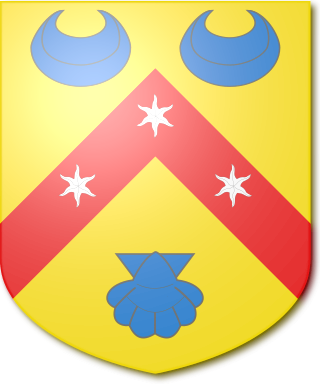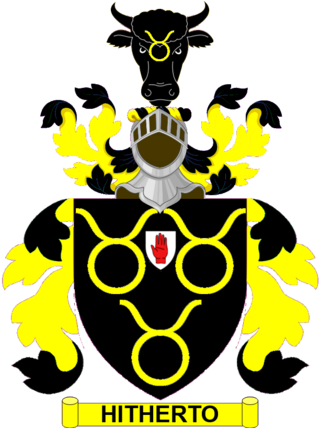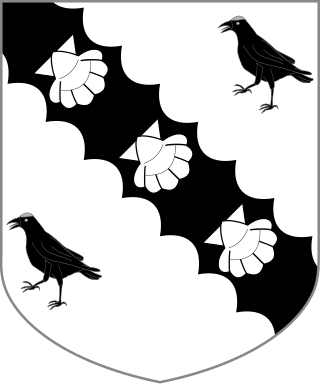
The White baronetcy, of Salle Park in the County of Norfolk, was created in the Baronetage of the United Kingdom on 29 June 1922 for Woolmer White. [1] The second Baronet represented Fareham in the House of Commons.

The White baronetcy, of Salle Park in the County of Norfolk, was created in the Baronetage of the United Kingdom on 29 June 1922 for Woolmer White. [1] The second Baronet represented Fareham in the House of Commons.
The heir apparent to the baronetcy is Kyle Dymoke Wilfrid White (born 1988), only son of the 4th Baronet. [5]
The Stronge baronetcy of Tynan was conferred in the Baronetage of the United Kingdom on 22 June 1803. The family were northern Irish landowners of Tynan Abbey, County Armagh, also possessing the residence of Lizard Manor, Aghadowey, County Londonderry.

The Henniker Baronetcy, of Newton Hall in the County of Essex, was created in the Baronetage of the United Kingdom on 2 November 1813 for Brydges Henniker, who had earlier represented Kildare Borough in the last Irish Parliament. He was the youngest son of John Henniker, 1st Baron Henniker. The sixth baronet was an admiral in the Royal Navy and sat as Conservative member of parliament for Galloway. The eighth Baronet was a brigadier in the Royal Engineers.

The Bull Baronetcy, of Hammersmith in the County of London, is a title in the Baronetage of the United Kingdom. It was created on 25 November 1922 for the Conservative politician Sir William Bull. He represented Hammersmith and Hammersmith South in the House of Commons for many years. His eldest son, the second Baronet, died on active service in the Second World War and was succeeded by his younger brother, the third Baronet. As of 2019 the title is held by the latter's grandson, the fifth Baronet, who succeeded in 2019.
There have been three baronetcies created for persons with the surname Primrose, two in the Baronetage of Nova Scotia and one in the Baronetage of the United Kingdom.
There have been four baronetcies created for persons with the surname Bell, all in the Baronetage of the United Kingdom. One creation is extant as of 2007.

The Baynes Baronetcy, of Harefield Place in the County of Middlesex, is a title in the Baronetage of the United Kingdom. It was created on 29 June 1801 for Christopher Baynes. He was Major-Commandant of the Uxbridge Gentlemen and Yeomanry Cavalry, which he helped to raise. The title descended from father to son until the death of his great-great-grandson, the fifth Baronet, in 1971. The late Baronet died unmarried and was succeeded by his first cousin, the sixth Baronet. He was the son of Reverend Malcolm Charles Baynes, fourth son of the third Baronet. As of 2023 the title is held by his grandson, the eighth Baronet, who succeeded his father in 2005.

The Dorman Baronetcy, of Nunthorpe in the County of York, is a title in the Baronetage of the United Kingdom. It was created on 21 July 1923 for the steel manufacturer Arthur Dorman. He was the founder and chairman of Dorman Long & Co, of Middlesbrough.

The Millais Baronetcy, of Palace Gate in Kensington in the County of Middlesex and of St Ouen in Jersey, is a title in the Baronetage of the United Kingdom. It was created on 16 July 1885 for the painter and illustrator John Everett Millais. He was one of the founders of the Pre-Raphaelite Brotherhood. As of 2014 the title is held by his great-grandson, the sixth Baronet, who succeeded his father in 1992.

The Maclure Baronetcy, of The Home in Whalley Range near Manchester in the County Palatine of Lancaster, is a title in the Baronetage of the United Kingdom. It was created on 12 March 1898 for John William Maclure. He was Secretary of the Famine Relief Fund from 1862 to 1865 and sat as Conservative Member of Parliament for Stretford between 1886 and 1901.

The Synge Baronetcy, of Kiltrough in the County of Meath, is a title in the Baronetage of the United Kingdom. It was created on 12 August 1801 for Robert Synge. The third Baronet served as High Sheriff of County Cork in 1844. The family surname is pronounced "Sing". As of 28 February 2014 the present Baronet has not successfully proven his succession and is therefore not on the Official Roll of the Baronetage, with the baronetcy considered dormant since 2011.

The Leeds Baronetcy, of Croxton Park in the County of Cambridge, is a title in the Baronetage of the United Kingdom. It was created on 31 December 1812 for George Leeds. He was an equerry to Prince Augustus Frederick, Duke of Sussex. The Croxton Park estate in Cambridgeshire had been in the Leeds family since circa 1568. As of 2011 the presumed ninth and present Baronet, a resident of Canada, has not successfully proven his succession and is not on the Official Roll of the Baronetage.

The Milman Baronetcy, of Levaton-in-Woodland in the County of Devon, is a title in the Baronetage of Great Britain. It was created on 28 November 1800 for Francis Milman, Physician-in-Ordinary to King George III and President of the Royal College of Physicians. The seventh Baronet was a brigadier-general in the British Army.
There have been three baronetcies created for personswith the surname Elphinstone, two in the Baronetage of Nova Scotia and one in the Baronetage of the United Kingdom. As of 2008 two of the creations are extant while one is dormant.

The Fleming, later le Fleming Baronetcy, of Rydal in the County of Westmorland, is a title in the Baronetage of England. It was created on 4 October 1705 for William Fleming, Member of Parliament for Westmorland. The second Baronet was Bishop of Carlisle. The third Baronet represented Cumberland in the British House of Commons. The fourth Baronet was Member of Parliament for Westmorland. He assumed the surname of le Fleming, an ancient version of the family surname. This version of the surname has also been borne by the Baronets from the seventh Baronet onwards. The sixth Baronet, an ordained priest, served as Rector of Windermere.

The Robinson Baronetcy, of Toronto in Canada, was created in the Baronetage of the United Kingdom on 21 September 1854 for the Canadian lawyer and politician John Robinson.
The Leigh Baronetcy, of Altrincham in the County of Chester, was created in the Baronetage of the United Kingdom on 9 February 1918 for the newspaper proprietor and Conservative politician John Leigh. He was owner of the Pall Mall Gazette and represented Clapham in the House of Commons between 1922 and 1945. During World War I he funded the equipment of a hospital for wounded officers at Altrincham. As of 2023 the baronetcy is held by his grandson, Sir Christopher Leigh, 4th Baronet, who succeeded his brother in the title in 2021.
The Stewart Baronetcy, of Balgownie in Bearsden in the County of Dumbarton, was created in the Baronetage of the United Kingdom on 16 December 1920 for James Watson Stewart. He was a member of the Glasgow Corporation from 1904 to 1920 and Lord Provost of Glasgow from 1917 to 1920.

The Scott baronetcy, of Beauclerc in the County of Northumberland, was created in the Baronetage of the United Kingdom on 27 July 1907 for the businessman Walter Scott.

The Smith baronetcy of Stratford Place in London was created on 6 September 1897 in the Baronetage of the United Kingdom for the surgeon Thomas Smith, on the occasion of the Diamond Jubilee of Queen Victoria, to whom he was surgeon extraordinary.

The Rowley baronetcy, of Hill House in the County of Berkshire, was created in the Baronetage of the United Kingdom on 21 March 1836 for the naval commander Admiral Charles Rowley. He was the fourth son of the 1st Baronet of the 1786 creation.